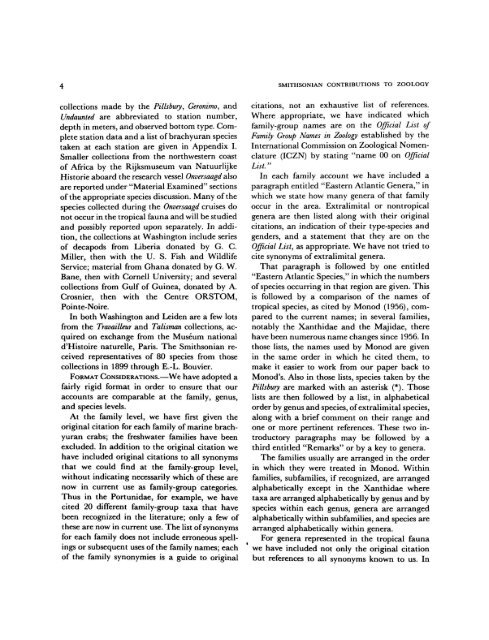West African Brachyuran Crabs - Smithsonian Institution Libraries
West African Brachyuran Crabs - Smithsonian Institution Libraries
West African Brachyuran Crabs - Smithsonian Institution Libraries
Create successful ePaper yourself
Turn your PDF publications into a flip-book with our unique Google optimized e-Paper software.
SMITHSONIAN CONTRIBUTIONS TO ZOOLOGY<br />
collections made by the Pillsbury, Geronimo, andcitations,<br />
not an exhaustive list of references.<br />
Undaunted are abbreviated to station number, Where appropriate, we have indicated which<br />
depth in meters, and observed bottom type. Com- family-group names are on the Official List of<br />
plete station data and a list of brachyuran species Family Group Names in Zoology established by the<br />
taken at each station are given in Appendix I. International Commission on Zoological Nomen-<br />
Smaller collections from the northwestern coast clature (ICZN) by stating "name 00 on Official<br />
of Africa by the Rijksmuseum van Natuurlijke List."<br />
Historie aboard the research vessel Onversaagd also In each family account we have included a<br />
are reported under "Material Examined" sections paragraph entitled "Eastern Atlantic Genera," in<br />
of the appropriate species discussion. Many of the which we state how many genera of that family<br />
species collected during the Onversaagd cruises do occur in the area. Extralimital or nontropical<br />
not occur in the tropical fauna and will be studied<br />
and possibly reported upon separately. In addition,<br />
the collections at Washington include series<br />
of decapods from Liberia donated by G. C.<br />
Miller, then with the U. S. Fish and Wildlife<br />
Service; material from Ghana donated by G. W.<br />
Bane, then with Cornell University; and several<br />
collections from Gulf of Guinea, donated by A.<br />
Crosnier, then with the Centre ORSTOM,<br />
Pointe-Noire.<br />
genera are then listed along with their original<br />
citations, an indication of their type-species and<br />
genders, and a statement that they are on the<br />
Official List, as appropriate. We have not tried to<br />
cite synonyms of extralimital genera.<br />
That paragraph is followed by one entitled<br />
"Eastern Atlantic Species," in which the numbers<br />
of species occurring in that region are given. This<br />
is followed by a comparison of the names of<br />
tropical species, as cited by Monod (1956), com-<br />
In both Washington and Leiden are a few lots pared to the current names; in several families,<br />
from the Travailleur and Talisman collections, ac- notably the Xanthidae and the Majidae, there<br />
quired on exchange from the Museum national have been numerous name changes since 1956. In<br />
d'Histoire naturelle, Paris. The <strong>Smithsonian</strong> re- those lists, the names used by Monod are given<br />
ceived representatives of 80 species from those in the same order in which he cited them, to<br />
collections in 1899 through E.-L. Bouvier. make it easier to work from our paper back to<br />
FORMAT CONSIDERATIONS.—We have adopted a Monod's. Also in those lists, species taken by the<br />
fairly rigid format in order to ensure that our Pillsbury are marked with an asterisk (*). Those<br />
accounts are comparable at the family, genus, lists are then followed by a list, in alphabetical<br />
and species levels.<br />
order by genus and species, of extralimital species,<br />
At the family level, we have first given the along with a brief comment on their range and<br />
original citation for each family of marine brach- one or more pertinent references. These two inyuran<br />
crabs; the freshwater families have been troductory paragraphs may be followed by a<br />
excluded. In addition to the original citation we<br />
have included original citations to all synonyms<br />
that we could find at the family-group level,<br />
without indicating necessarily which of these are<br />
now in current use as family-group categories.<br />
Thus in the Portunidae, for example, we have<br />
cited 20 different family-group taxa that have<br />
been recognized in the literature; only a few of<br />
these are now in current use. The list of synonyms<br />
for each family does not include erroneous spellings<br />
or subsequent uses of the family names; each<br />
of the family synonymies is a guide to original<br />
third entitled "Remarks" or by a key to genera.<br />
The families usually are arranged in the order<br />
in which they were treated in Monod. Within<br />
families, subfamilies, if recognized, are arranged<br />
alphabetically except in the Xanthidae where<br />
taxa are arranged alphabetically by genus and by<br />
species within each genus, genera are arranged<br />
alphabetically within subfamilies, and species are<br />
arranged alphabetically within genera.<br />
For genera represented in the tropical fauna<br />
we have included not only the original citation<br />
but references to all synonyms known to us. In

















